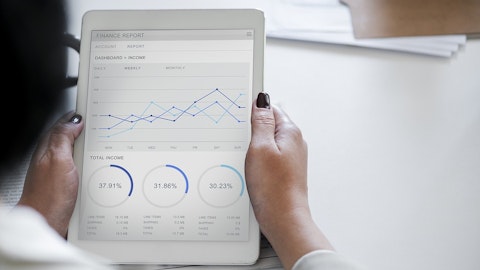Futu Holdings Limited (NASDAQ:FUTU) Q3 2022 Earnings Call Transcript November 21, 2022
Futu Holdings Limited beats earnings expectations. Reported EPS is $0.73, expectations were $0.57.
Operator: Hello, ladies and gentlemen. Welcome to Futu Holdings Third Quarter 2022 Conference Call. At this time, all participants are in a listen-only mode. After management’s prepared remarks, there will be a Q&A session. Today’s conference call is being recorded. If you have any objections, you may disconnect at this time. I would now like to turn the conference over to your host for today’s conference call, Daniel Yuan, Chief of Staff and Head of IR at Futu. Please go ahead, sir.
Daniel Yuan: Thanks, operator, and thank you for joining us today to discuss our third quarter 2022 earnings results. Joining me on the call today are Mr. Leaf Li, Chairman and Chief Executive Officer; Arthur Chen, Chief Financial Officer; and Robin Xu, Senior Vice President. As a reminder, today’s call may include forward-looking statements, which represent the Company’s belief regarding future events, which by their nature are not certain and are outside of the Company’s control. Forward-looking statements involve inherent risk and uncertainty. We caution you that a number of important factors could cause actual results to differ materially from those contained in any forward-looking statements. For more information about the potential risks and uncertainties, please refer to the Company’s filings with the SEC, including its registration statement. So, with that, I will now turn the call over to Leaf. Leaf will make his comments in Chinese and I will translate.

Photo by AlphaTradeZone
Daniel Yuan: Thank you all for joining us today. As of quarter end, we had 1.44 million paying clients, representing a 24% year-over-year growth. In the third quarter, we added 58,000 paying clients, a 5% sequential decline due to stock market tumble. Despite the market downturn, we achieved over 98% quarterly paying client retention rate for each of the five countries and regions for the first time. Our industry-leading retention metric speaks to the stickiness of our product and the resilience of our premier client base.
Daniel Yuan: In Singapore, new paying client growth accelerated by over one-third sequentially as we successfully launched targeted online and offline marketing campaigns around mutual funds and expanded client acquisition channels. We were able to attract many allocation driven clients who gravitated towards lower risk mutual funds, amid market volatility. In the U.S. market, client growth remained robust as we iterated on online marketing and deepened our collaboration with KOLs. The deceleration of client acquisition in Hong Kong was mainly due to sluggish equity market performance and to a lesser extent limited traction of our promotions around silver bond. Residents between the age of 35 and 55 will remain our priority in Hong Kong, as our current penetration is around 10%, offering significant room for further growth.
Daniel Yuan: Total client assets declined 13% year-over-year and 15% quarter-over-quarter to HK$370 billion. While the challenging equity market weighed on client portfolio valuations, net asset inflow remained strong. In Singapore, total client assets grew by 11% quarter-over-quarter due to higher-quality new clients and strong asset inflows.
Daniel Yuan: Total trading volume declined 19% sequentially to HK$1.1 trillion, of which U.S. stock trading constituted 69%. Lower turnover of technology names led to a 16% sequential decline in the U.S. stock trading volume, partially offset by strong trading interests in leveraged and inverse ETFs. Hong Kong stock trading volume was HK$304 billion, down 28% sequentially amid deteriorating market sentiments across all sectors. Margin financing and securities lending balance increased by 2% sequentially, driven by clients’ bottom fishing of Chinese new economy names.
Daniel Yuan: Client assets in wealth management grew 47% year-over-year and 19% quarter-over-quarter to HK$26 billion. In Singapore, we became exclusive distributor of a newly launched USD-denominated money market fund with people zero settlement, the first of its kind in Singapore. We also introduced SmartSave in Singapore, which gives our clients the option to automatically subscribe for and redeem money market funds, based on the cash positions in their trading accounts. We were intentional about adding money market products and enhancing their functionality amid a rate hike environment, thereby growing our wealth management assets in Singapore by 5-fold quarter-over-quarter. Client assets in private funds increased by 67% sequentially, mainly attributable to a new cash management product that offers 4.2% expected annualized return for professional investors with a one month lockup.
As of quarter end, wealth management penetration among paying clients increased from 15% in the second quarter to 17%, as we continue to expand fund offerings and upgrade product features.
Daniel Yuan: Our enterprise business had 301 IPO and IR clients as well as 572 ESOP clients as of quarter end, up 40% and 76% year-over-year, respectively. Over 50 companies adopted our ESOP services during the quarter, including Ganfeng Lithium and MicroPort. In the first three quarters of this year, we underwrote 23 Hong Kong IPOs and ranked second among all brokers, according to Wind.
Daniel Yuan: Next, I’d like to invite our CFO, Arthur to discuss our financial performance.
Arthur Chen: Thanks Leaf and Daniel. Please allow me to walk you through our financial performance in the third quarter. All the numbers are in Hong Kong dollars unless otherwise noted. Our total revenue was HK$1.9 billion, up 12% from HK$1.7 billion in the third quarter of 2021. Brokerage commission and handling charge income was HK$958 million, an increase of 3% year-over-year and a decrease of 7% Q-o-Q. The year-over-year increase was mainly driven by a higher blended commission rate of 8.8 basis points, up from 6.9 basis points in the year ago quarter. The Q-o-Q decrease was due to close to 20% sequential decline in trading volume, partially offset by the higher blended commission rate. Interest income was HK$881 million, an increase of 39% year-over-year and 42% Q-over-Q.
The year-over-year increase was mainly due to higher income from cash deposits, which more than offset lower margin financing income and IPO financing interest income. The Q-o-Q increase was mostly attributable to higher interest income from cash deposits and higher margin financing income. Other income was HK$107 million down 36% year-over-year and up 16% Q-over-Q. The year over year decrease was mainly due to lower IPO financing service charge income, enterprise public relationship service charge income and the currency exchange service income. The Q-over-Q increase was mainly due to some one-off income items. Our total costs were HK$218 million, a decrease of 18% from HK$267 million in the third quarter of 2021. Brokerage commission and handling charge expenses were at HK$83 million, down 34% year-over-year and 5% Q-over-Q.
See also 12 Countries That Produce the Best Coffee and 12 Countries That Produce The Best Cosmetics.
The commission expenses didn’t move in line with brokerage commission income due to the cost saving from our U.S. sales clearing migration and upgrade service package with our U.S. clearinghouse. The Q-over-Q decrease was mainly due to lower trading volume. Interest expenses were HK$41 million, down 40% year-over-year and up 6% to 8% Q-over-Q. The year-over-year decrease was mostly due to lower expenses from interest — from margin financing and the securities lending. The sequential uptick was driven by higher daily average margin financing balance and higher blended funding costs amid rate hike. Processing and servicing costs were HK$91 million, up 35% year-over-year and down 3% Q-over-Q. The year-over-year increase was primarily driven by higher cloud service fees to support our overseas market expansion.
As a result, total gross profit was HK$1.7 billion, an increase of 18% from HK$1.5 million in the third quarter of 2021. Gross margin was 89% expanded from 85% in the third quarter of 2021. Operating expenses were HK$761 million, down 0.3% year-over-year, up 5% Q-over-Q. R&D expenses were HK$313 million, up 40% year-over-year and 7% Q-over-Q. The increase was mainly due to increasing R&D headcount as we continue to support new product offering, invest in U.S. sale clearing capabilities and the customized product experience for different new markets. Selling and market expenses were $235 million, down 42% year-over-year, up 7% Q-over-Q. The year-over-year decrease was mainly due to slowing paying client growth. Expenses increased Q-over-Q as client acquisition costs hiked due to weak market sentiment.
G&A expenses were HK$212 million, up 55% year-over-year and 1% Q-over-Q. The increase was primarily due to increase in headcount for general and administrative personnel. As a result, our net income increased by 23% year-over-year and 18% Q-over-Q to HK$755 million. Net income margin expanded to 39% in the third quarter as compared to 36% in the same quarter last year. Our effective tax rate for the quarter increased to 12.2% as the tax credit from our U.S. clearing has been fully utilized. That concludes our prepared remarks. We now like to open the call to questions. Operator, please go ahead.
Q&A Session
Follow Futu Holdings Ltd (NASDAQ:FUTU)
Follow Futu Holdings Ltd (NASDAQ:FUTU)
Operator: Thank you. We’ll now take our first question. Please stand by. This is from the line of Cindy Wang from China Renaissance. Please go ahead.
Cindy Wang: My first question is regarding to the interest income in third quarter. Things are interesting, show very strong growth in third quarter. Could you give us a breakdown by margin financing income, bank deposit and IPO financing interest income in third quarter? Since Fed rate hike was another 75 bps in November and possibly to raise another 50 bps in December, how do you see the contribution from bank deposit in fourth quarter? The second question is regarding to the commission rate. In third quarter, the commission rate was up again to 8.8 bps. Could you give us the reasoning behind it, and how sustainable for the rate in fourth quarter? Thank you.
Arthur Chen: Thank you, Cindy. This is Arthur. I’ll take two of your questions. First of all, the interest income. I think the contribution from the IPO margin financing is relatively small. So, most of our interest income now comes from the client’s idle cash and also our margin business, which I think you’re right, we are one of the beneficiaries from the rate hike cycle. Especially in the first quarter we see we see the contribution from the — client deposits becomes more meaningful. And down the line I think on a like for like basis, it may contribute even more interest income in the fourth quarter. But having said that, you can understand that our interest income actually comes from two parameters, one is the interest rate i.e. the deposit rate we get from the banks.
The other is the clients’ idle cash average balance which may be related to the market volatilities. For instance in the third quarter, the market becomes very challenging and we can see the average cash balance among our clients become much higher, they lower down their stock position. So, I’m not sure whether such allocations, both as a clients’ stock and clients’ cash will remain in the fourth quarter or not. But if assumed such ratio remained the same versus the third quarter, I think we will get more interest income in the fourth quarter. For your second question about the blended commission rate, that comes from several factors. Number one, as Leaf mentioned, in the third quarter, our U.S. trading contributions roughly account for close to 17%, which has positively impacted our blended commission rate.
It is very difficult to forecast whether such positives will continue or not, given it is more driven by the market conditions. And secondly, the trading volatility in the third quarter comes — more clients trading derivative such options and the futures et cetera. In third order, our trading commission — among our trading commission, roughly 30% came from client activities in the derivatives. So, it will enhance our blended commission rate as well. Thank you.
Cindy Wang: Thank you. Very clear.
Operator: Thank you. We’ll now take our next question. Please stand by. This is from the line of Zoey Zong from Jefferies. Please go ahead.
Zoey Zong: Thank you, management, for taking my questions. This is Zoey Zong from Jefferies. Congratulations on solid results. And I have two questions. So first, we have already achieved our annual target of acquiring 200,000 new paying clients. So wondering, based on the current market conditions, could you please provide some color about our user acquisition in Q4 and next year? And my second question is regarding our Singapore business. As we have seen strong growth in the number of new paying clients and client assets, wondering how many total paying clients do we have in Singapore as of Q3, and what about the average asset for paying clients? How do we think about the penetration rate and upside? Thank you.
Arthur Chen: Thank you, Zoey. I will take your first question and I will leave your second question to my colleagues, regarding the situation in Singapore. For your first question, you are right. We are already approaching our full year guidance for 200,000 in new paying clients acquired this year. Quarter-to-date, I think you can understand and everybody can imagine the market condition was quite challenging across the U.S. and also the Asian markets as well. So, based on the current quarter-to-date run rate, we think the new clients acquired in the fourth quarter may be smaller or slower than the third quarter. But we are very confident we will continue to acquire clients across the different markets. And also quarter to date we still record decent net asset inflows across the different markets.
It is too early to give you some sense or the guidance for our next year’s — the new paying clients guidance. We will keep you posted in our fourth quarter earnings call. Thank you.





